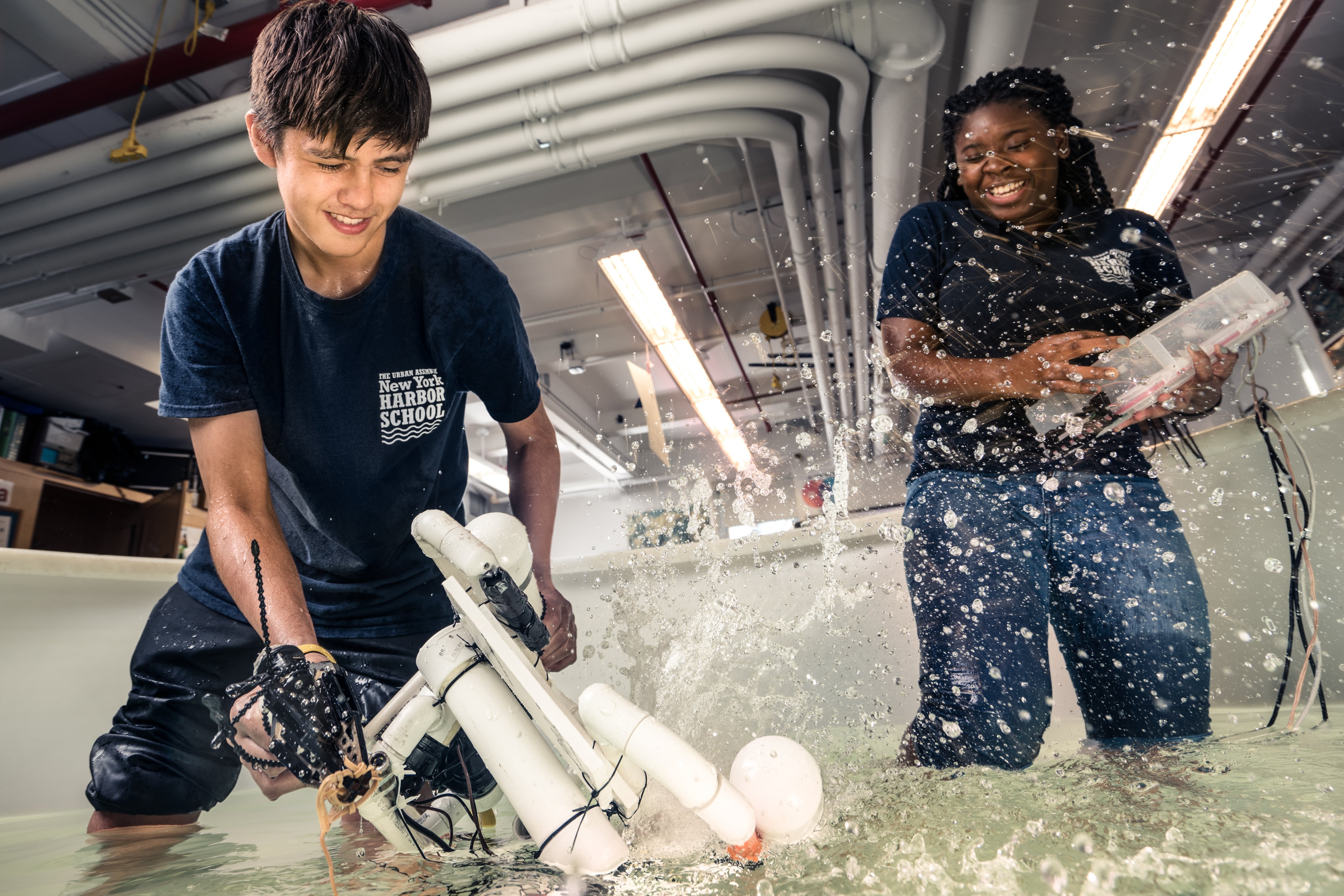New York City is largely a collection of islands, but just one high school is only accessible by boat: Urban Assembly New York Harbor School.
The school opened 20 years ago landlocked in Bushwick, and in 2010 moved to Governors Island, a 172-acre teardrop-shaped parcel that’s about an eight-minute ferry ride from Lower Manhattan. Now the Harbor School will be doubling its footprint on Governors Island, expanding from two to four buildings, city officials announced Tuesday.
The move will add classrooms and other new facilities, including a competition-sized pool, gymnasium, and lab space to support the school’s maritime and environmental curriculum that is rooted in career and technical education, or CTE, with seven tracks such as aquaculture, marine biology research, vessel operations, and professional diving. The school also partners with the Billion Oyster Project, which aims at restoring the city’s harbor with the mollusks that used to be plentiful before the 1900s.
“For many New Yorkers, Governors Island is a place to get away over the weekend. And for so many others, it is a place to learn about our world or prepare our city for the threats of climate change,” Mayor Eric Adams said in a statement. “This project will give our young people the best of all worlds: a holistic, high-quality education, brand new facilities to help students learn, and access to one of our city’s gems where nature truly is the classroom.”
City officials did not provide a price tag for the project and did not yet have a time line.
The expansion project includes the renovation of Building 555, a designated landmark originally constructed in 1938 as family housing by the United States Army. The other will be a new building, the first new construction located within a development zone on the island since its transfer from federal to local control in 2003.
The new building will be part of a bigger Center for Climate Solutions that the Trust for Governors Island is creating to expand learning and training opportunities for students on Governors Island as part of an initiative to position New York City as a global leader on responding to the climate crisis. The trust is currently in the process of finding an educational and research institution to anchor the center, whose mission supports Adams’ economic recovery blueprint.
Looking to ease waitlist
“We’re doing something that’s unique, and we’re doing it well and in a place that is accessible for students from all five boroughs,” said Jeffrey Chetirko, who has been the school’s principal since 2015.
He is hopeful that the school, an unscreened school that is part of Manhattan’s District 2, will be able to go from its roughly 520 students to nearly 900 with the expansion.
“My waitlist is ridiculous,” said Chetirko, who gets daily phone calls from families to see if there are open seats.
The Harbor School boasts committed educators who teach skills that are not often found in New York City high schools — or anywhere. Rob Markuske, a former national park ranger, oversees the school’s Marine Affairs and Policy program. Mauricio Gonzalez, the school’s work-based learning coordinator, holds an annual science symposium matching students with mentors from all over the world studying creatures living on the sea floor bottom, doing GIS studies on environmental impacts, and more. Lenny Speregen, a former movie stunt man, leads the school’s dive instruction program, the only such program in the nation.
But the students have had to travel to its former home in Bushwick to use the pool for diving lessons. Chetirko is excited that a new swimming pool would not only help its students, but he sees it as a potential resource for the city, with lessons for students from across the city after school and on weekends. He envisions it as a training ground for future lifeguards in a city chronically understaffed with such workers.
The Harbor School is one of the more diverse schools in one of the nation’s most segregated school systems, and has been part of the city’s “diversity in admissions’’ program since 2018, with 70% of this year’s seats for incoming freshmen reserved for students from low-income families. After noticing a greater number of applicants from affluent families who had second houses and boats, Chetirko wanted to ensure the school stayed true to its roots of working with students who long had little access or experience with the waterfront.
In addition to its racial diversity (41% Latino, 26% white, 17% Black, and 7% Asian), more than a quarter of its students have disabilities.
Ferry commute woes
Getting to the school can be a challenge for some students. The ferry from Manhattan is free, but the ferry from Brooklyn is not. It will cost $4 starting Sept. 12, up from $2.75, although the fare will drop to $1.35 for low-income residents.
For the school’s students from Red Hook, the commute would be about 4 minutes by boat across Buttermilk Channel instead of the 80-minute commute by train into Manhattan to take the ferry from there. Plus, Red Hook’s new maritime middle school is opening this year, and the Harbor School hopes its graduates will eventually choose to attend the Harbor School.
“We shouldn’t have to spend money we don’t have just to get to school on time,” recent graduate Gabriella McCalpin said in a statement last spring as part of the school’s “Free the Ferries” campaign. “Our focus should be on learning – not stressing over how we’re going to get to show up for class.”
The school’s attendance rate was still relatively high at more than 92%, Chetirko said, but the roundabout commutes for some students mean they can’t participate in after-school programs. Students are pushing for the city to give free ferry rides to those who qualify for free MetroCards.
In response to questions about the campaign, education department officials simply pointed to the free ferries from Manhattan.
Amy Zimmer is the bureau chief for Chalkbeat New York. Contact Amy at azimmer@chalkbeat.org.







